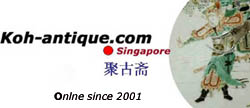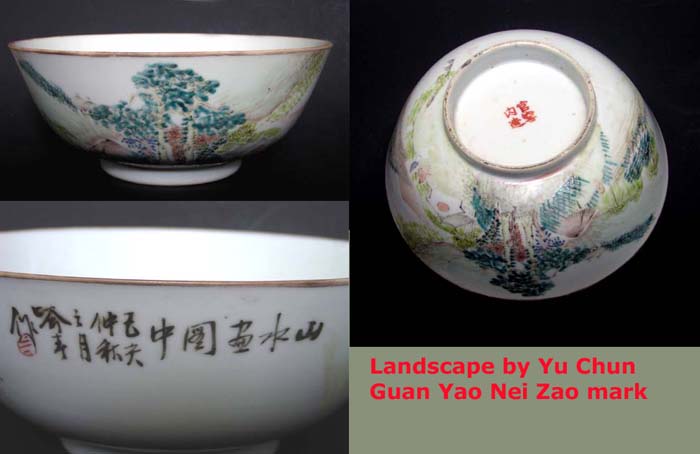
Qianjiang Porcelain - Some additional thoughts and views
Definition of Qianjiang
The term Qianjiang cai (enamels) or Qianjiang porcelain was only coined in the 1950s. Prior to that, annals or commentaries in late Qing and Republican period did not classify it as a new type of over-glaze enamel technique on porcelain. The term Qianjiang was initially used to describe the type of “浅洚山水” landscape painting by Yuan master literati painter Huang Gongwang. It is typified by use of a particular colour scheme: varying ink tone for outline, mass , area in shade of mountain/ tree trunk and reddish-brown for other aspects such as the foliage, water and the lighted area of the mountain. The term was subsequently used to describe porcelain painting (inclusive of all subjects such as landscape, huan figures, bird/floral) which used similar colour scheme but with additional colour such as aquamarine, moss green, pale blue. and light pink. A typical early Qianjiang work applied thinner enamels and used less strong colours. Due to its subdued colour tones, visually the painting has a quiet and delicate feeling. These are distinctive features of the literati school of paintings. In fact, those initial works were done by a small circle of cultivated artists who were well-versed in Chinese literature and highly skilled painters and calligraphers. The pioneers include Cheng Men,Jin Pin Qing and Wang Shao Wei who had worked in the imperial kiln. Such qianjiang porcelains were probably initially produced for the gentry class. But subsequently to cater to a wider market including the wealthy merchant class and common folks, the style of the painting evolved to satisfy their taste and preference. Temperamentally, the common folks appreciate more vibrant colours which convey a gaiety, vibrancy and sense of well-being. Hence, many of the later Qianjiang porcelains used stronger colours. Thus it gives rise to the issue of whether this category could be be classified as Qianjiang painting. The impression of light colour tone is also highly subjective and has given rise to current confusion and divergent views. This is especially so when deciding whether some of those bird/floral motif with strong pink and green enamels are qianjiang. Personally I think excluding such pieces as not qianjiang works missed the essence of definition of Qianjiang in the context such art form on ceramics. The key differences should be viewed from the technical and stylistic angles:
a) the enamels for Qianjiang are also fencai. The main difference is the application of the cobalt black colour. For Qianjiang, it is not covered with a layer of a transparent lead-based substance. Insted lead is mixed with cobalt and applied directly to the glazed surface. This difference in application allows for more tonal differences and visually the effect is more akin to the effect of the black of chinese painting on paper and silk.
b) for fencai, before the required enamel is used to fill the outline, a arsenic-based opaque white pigment is first applied to the area. With the enamel mixed with different amount of this opaque substance, tonal gradations which gives the painting its 3-dimensional look can be achieved. Whereas for most Qianjiang, the enamel is applied directly without the opaque white pigment. Hence, the enamels is thin and lack tonal gradations.
c) stylistically, it enables the introduction of literati style of paintings on porcelain medium. On most works, the composition incorporated calligraphic inscription/poem, seal marks. The work is the creative effort of a single artist whereas those traditional fencai and wucai (famille verte) works were the result of division of labour.
The most important contribution of the Qianjiang artists is the introduction of literati style painting on porcelain medium. It has resulted in the the subsequent change of perception and the recogniiton that the potters are not just craftsmen. Since then, ceramic paintings has further evolve and enriches chinese painting as an art form.

The Imperial Kiln Connection
Two Qianjiang pioneers, Jing PinQing and Wang Shaowei had worked in the imperial kiln. This is convincingly established by Mr Liu Xinyuan in the book "Brush and Clay" by Simon Kwan. Mr Liu interview Li Qi, a descendant of Li Yingzhou who headed the imperial factory in the Tongzhi period. Jing and Wang wee than known as the "two brushes of the imperial factory". One of the known work by Jin indicated that it was painted at Huan Cui Pavalion ( 环翠亭 ) and another by Wang done at Bangong garden (半弓园), both located within the imperial factory compound.
In fact, some known works by other Qingqiang artists also indicated the works were done at "珠山官廨" or "珠山官舍" ie Zhushan government factory or dormitory. Another interesting observation is a group of qingjiang pieces with the mark "官窑内造", ie "Guan Yao Nei Zao" literally means made within the imperial kiln. This may be a marketing strategy by the imperial kiln artists to differentiate their products. Generally those with this mark are of good quality.

Qianjiang pieces from Chinese collectors:
1, 2, 3, 4, 5, 6, 7, 8, 9, 10, 11, 12, 13, 14, 15, 16, 17, 18, 19, 20, 21, 22, 23, 24, 25, 26, 27, 28, 29
By: NK Koh (last update: 26 Feb 2008)